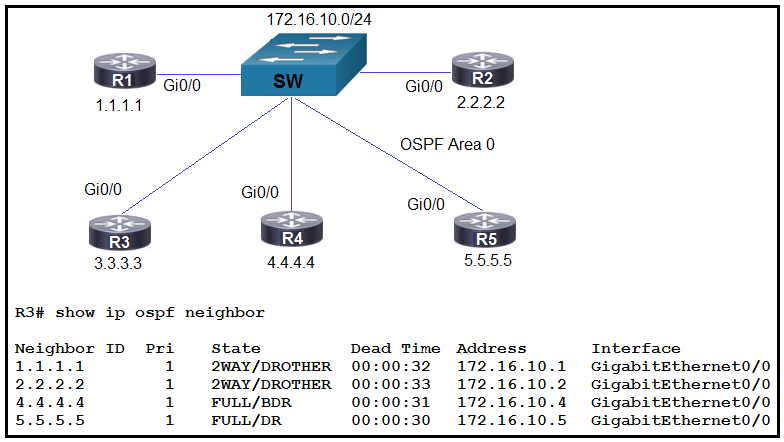
Refer to the exhibit. R5 is the current DR on the network, and R4 is the BDR. Their interfaces are flapping, so a network engineer wants the OSPF network to elect a different DR and BDR. Which set of configurations must the engineer implement?

Refer to the exhibit. R5 is the current DR on the network, and R4 is the BDR. Their interfaces are flapping, so a network engineer wants the OSPF network to elect a different DR and BDR. Which set of configurations must the engineer implement?
To influence the OSPF DR (Designated Router) and BDR (Backup Designated Router) elections, the OSPF priority setting on router interfaces must be adjusted. In OSPF, the router with the highest priority becomes the DR, and the router with the next highest priority becomes the BDR. With all routers currently having the default priority of 1, increasing the priorities on specific routers will ensure they are elected as the new DR and BDR. Option C sets the priorities to 255 and 240 on R3 and R2 respectively, which will make these routers the highest priorities in the network, ensuring they are elected as the new DR and BDR. The maximum OSPF interface priority is 255, and assigning these values unequivocally achieves the desired result.
Max priority is 255 and all routers here have priority 1. DR/BDR election's based on highest priority!
highest metrik is DR. max 255
This really depends on what the question is trying to ask. Yes option C will also achieve the same effect but you are manually forcing R3 and R2 to become DR and BDR. The question only asked for you to have OSPF elect a different DR and BDR so I think A fits best as it will leave OSPF to elect a DR and BDR instead of you basically forcing it.
I messed up OSPF's default priority value is 1 so A would do nothing. ANSWER IS C.
C is correct D is incorrect because OSPF priority range is 0-255 so its out of range
The answer is C - manually forcing the priority
why it can't be A? It also change the DR and BDR
The route with a priority of 255 is selected due to the fact that this is the Max value. This forces the configuration to elect the router with this priority. It is not recommended to use priority 255 unless it is really necessary.
It took me a while to realize that router 3 is NOT in the OSPF “neighborhood” (check the exhibit). Maybe that’s why answer A is correct and C is not.
I’m sorry. My bad here. Disregard my previous comment. Of course router 3 is in the OSPF neighborhood.
its because the command was done on R3 so the list shows its neighbors
The question only asks us to change the current conditions. So both A and C provide the answer. This question is broken. Anyway I will go with C
why not D?
OSPF priority range is 0-255. D is out of range
because the value can go from 0 to 255 (default = 1): with 0 you avoid the election to DR / BDR, with higher values you can drive it at will. If all the routers on the LAN have priority = 0, OSPF will not work